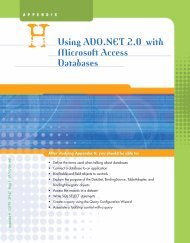Create successful ePaper yourself
Turn your PDF publications into a flip-book with our unique Google optimized e-Paper software.
Appendix C C-47<br />
PROJECT<br />
A Linear Approximation for the Sine Function<br />
In this project we derive the following very important property of the sine<br />
function:<br />
sin u<br />
For real numbers u, the ratio approaches 1 as u approaches zero.<br />
u<br />
In the phrase “as u approaches zero” (in the domain of sin u) it is important to<br />
understand that u cannot be zero because we can’t substitute zero for u in our<br />
trigonometric ratio.<br />
To begin we need a preliminary result:<br />
For real numbers u, cos u approaches 1 as u approaches zero.<br />
Exercise 1 Convince yourself that this preliminary result is true in each of<br />
the following ways.<br />
(a) By looking at the graph of y cos u, for p4 u p4, in a u-y coordinate<br />
system.<br />
(b) By looking at a point (cos u, sin u) on the unit circle.<br />
In both parts (a) and (b), be sure to consider u approaching zero through both<br />
positive and negative values.<br />
Now consider real numbers u approaching zero through positive values.<br />
Eventually u p2 so we may assume 0 u p2. In Figure A we have the<br />
unit circle with various labeled points:<br />
O is the origin.<br />
A is the point (1, 0).<br />
P is the point on the unit circle corresponding to the number u, or,<br />
equivalently, the angle with radian measure u.<br />
B is the point at the foot of the perpendicular from P to the x-axis.<br />
Q is the vertex of ^OAQ lying on the terminal side of angle u outside<br />
the unit circle; the line through Q and A is tangent to the circle.<br />
y<br />
Q<br />
O<br />
¨<br />
P<br />
B<br />
A<br />
x<br />
Q(1, tan ¨)<br />
P(cos ¨, sin ¨)<br />
¨<br />
Figure A<br />
≈+¥=1<br />
¨<br />
O B(cos ¨, 0)<br />
Figure B<br />
A(1, 0)<br />
Exercise 2 In Figure A explain why OAQ is a right angle. Then explain why<br />
P (cos u, sin u), B (cos u, 0), and Q (1, tan u)<br />
The information from Exercise 2 is shown in Figure B.
















